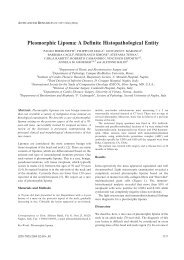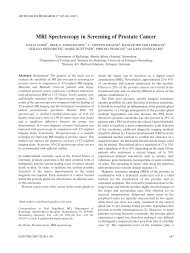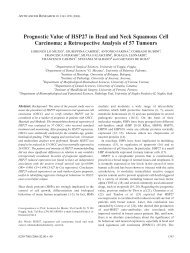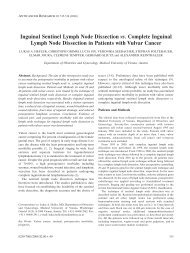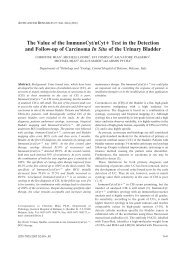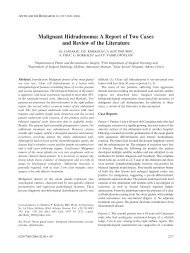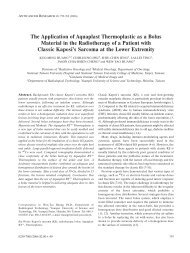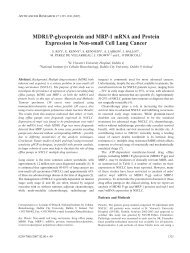ABSTRACTS OF THE 21st ANNUAL MEETING OF THE ITALIAN ...
ABSTRACTS OF THE 21st ANNUAL MEETING OF THE ITALIAN ...
ABSTRACTS OF THE 21st ANNUAL MEETING OF THE ITALIAN ...
You also want an ePaper? Increase the reach of your titles
YUMPU automatically turns print PDFs into web optimized ePapers that Google loves.
the surgical specimens and 20.2% in the postmortem cases.<br />
Tumors can metastasize to the bladder by direct spreading or<br />
by means of hematogenous or lymphatic spread (2). In one<br />
study, approximately 54% of metastases from bladder cancer<br />
were located near the bladder neck and trigone areas, however,<br />
metastatic colon cancer commonly involves the fundus (3).<br />
The treatment of secondary bladder cancer can be performed<br />
by an open or transurethral resection, and/or by a combination<br />
of chemo- and radiotherapy. However, due to the rarity of<br />
these conditions and to the lack of any large series comparing<br />
the various surgical options, the optimal treatment is unclear.<br />
The possibility of metastasis should be considered in patients<br />
with a history of colonic adenocarcinoma who present with<br />
adenocarcinoma of the bladder. The use of an<br />
immunohistochemical panel is recommended to differentiate<br />
between primary and metastatic tumors (3).<br />
1 Kobayashi T, Kamoto T, Sugino Y, Takeuchi H, Habuchi T<br />
and Ogawa O: High incidence of urinary bladder<br />
involvement in carcinomas of the sigmoid and rectum: a<br />
retrospective review of 580 patients with colorectal<br />
carcinoma. J Surg Oncol 84(4): 209-214, 2003.<br />
2 Bates AW and Baithun SI: Secondary neoplasms of the<br />
bladder are histological mimics of nontransitional cell<br />
primary tumors: clinicopathological and histological features<br />
of 282 cases. Histopathology 36(1): 32-40. 2000.<br />
3 Velcheti V and Govindan R: Metastatic cancer involving<br />
bladder: a review. Can J Urol 14(1): 3443-3448, 2007.<br />
125<br />
SETUP ACCURACY WITH <strong>THE</strong> USE <strong>OF</strong> CBCT<br />
IMAGE-GUIDED RADIO<strong>THE</strong>RAPY IN <strong>THE</strong><br />
TREATMENT <strong>OF</strong> PROSTATE CANCER<br />
Francesco Dionisi, Barbara Bortolato, Francesco Bracco and<br />
Mauro Palazzi<br />
Radioterapia Oncologica, Azienda Ospedaliera Niguarda Ca’<br />
Granda, Milano, Italy<br />
Background: Modern radiotherapy in prostate cancer can be<br />
delivered with sophisticated techniques, such as 3D conformal<br />
radiotherapy, and intensity modulated radiation treatment<br />
(IMRT), which allow for a shaped distribution of dose around<br />
the target with an acceptable toxicity for the nearby healthy<br />
organs (bladder, rectum). There has also been a parallel<br />
advancement in the methods available to verify accuracy of<br />
the patient setup. The aims of the present study were: (i) to<br />
evaluate the effectiveness of cone beam-computed tomography<br />
(CBCT) to determine set-up accuracy in radiotherapy<br />
treatment for prostate cancer; and (ii) to validate an internal<br />
online correction protocol with the goal of reducing systematic<br />
1874<br />
ANTICANCER RESEARCH 31: 1807-1956 (2011)<br />
errors, thus establishing the proper clinical target volume<br />
(CTV) to planning target volume (PTV) margin. Patients and<br />
Methods: The study population consisted of 20 low-<br />
/intermediate-risk prostate cancer patients undergoing<br />
definitive radiotherapy to a total dose of 76 Gy with the use<br />
of an Elekta linear accelerator mounting a CBCT scanner<br />
(Elekta Synergy S, Elekta Oncology Systems Ltd, Crawley,<br />
U.K.). Patients were treated in the supine position with a full<br />
bladder and empty rectum; proper immobilization devices<br />
(Orfit industries, Wijnegem, Belgium) were adopted. The CTV<br />
was identified as the prostate gland and the entire seminal<br />
vesicles plus a 7 mm margin everywhere, except for 5 mm in<br />
the posterior direction and for 1 cm in the superoinferior (SI)<br />
direction. Pre-treatment image registration was performed<br />
using a soft-tissue algorithm applied to a region of interest<br />
including the whole PTV. CBCT was executed for the first<br />
three fractions to detect systematic errors with an action level<br />
of 3 mm; subsequent registrations were performed every seven<br />
fractions. Only translational (no rotational) errors were<br />
considered by the present analysis. The overall mean shift (M),<br />
the SD of the group systematic error (Σ), the root mean square<br />
of the SD of all patients (σ) and the 3D vector of displacement<br />
were calculated. The Van Herk formula (1) (2.5 Σ+ 0.7 σ) was<br />
used to determine CTV to PTV margins. The impact of the<br />
correction protocol was determined by quantifying the set-up<br />
accuracy without the application of systematic adjustments.<br />
Results: A total of 168 CBCT scans (average 8 per patient,<br />
range 6-11), resulting in 504 positional errors along the<br />
mediolateral (ML), SI and anteroposterior (AP) axes, were<br />
analyzed. A systematic correction was requested in 60% of<br />
patients, mostly (66%) in AP direction. The values of M were<br />
−0.2, 1.5 and 0.8 mm in the 3 axes, respectively. The SD of<br />
the group systematic error (Σ) was 1.8, 2.1 and 1.9 mm along<br />
ML, SI and AP directions, respectively; these values rose to<br />
2.5, 2.5 and 4.1 mm in the 3 axes if systematic corrections<br />
were not considered. The values of σ were 2.4, 3.3 and 3.6<br />
mm in the three directions. The mean 3D vector of<br />
displacement was 3.48±1.4 mm. CTV-PTV margins were<br />
6.18, 7.56 and 7.27 mm along the three axes. In the absence of<br />
systematic corrections, a CTV-PTV margin of 7.93, 8.59 and<br />
12.77 mm in ML, SI and AP directions was required,<br />
respectively. Discussion and Conclusion: CBCT image<br />
registration ensures accurate targeting in prostate radiotherapy.<br />
The internal correction protocol allowed for a significant<br />
reduction of CTV-PTV margins, especially in the AP<br />
direction. A PTV margin of 8 mm in all directions seems<br />
appropriate: a margin of 5 mm in the posterior direction to<br />
reduce rectal toxicity could be achievable (i) by the<br />
introduction of a dietary protocol (2) to decrease both<br />
systematic and random errors, and (ii) by increasing the<br />
number of image-guided fractions. The acquisition of posttreatment<br />
CBCT might be helpful in quantifying intrafraction<br />
prostate motion.



